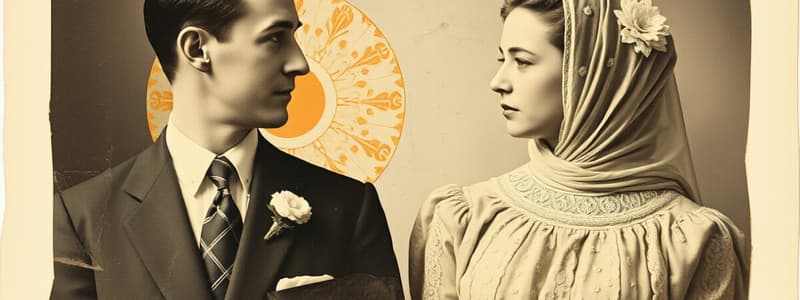Podcast
Questions and Answers
What is institutional marriage primarily characterized by?
What is institutional marriage primarily characterized by?
- Marriage involving gender equality
- Marriage with flexible roles
- Marriage based on love and attraction
- Marriage as a necessity (correct)
What term refers to spouses who work together to fulfill duties in institutional marriage?
What term refers to spouses who work together to fulfill duties in institutional marriage?
Yoke mates
Institutional marriage was based on love and emotional connection.
Institutional marriage was based on love and emotional connection.
False (B)
Institutional marriages were often characterized as very _____ and practical.
Institutional marriages were often characterized as very _____ and practical.
When did companionate marriage emerge?
When did companionate marriage emerge?
What ideal became important in companionate marriages?
What ideal became important in companionate marriages?
Companionate marriage is characterized by rigid gender roles.
Companionate marriage is characterized by rigid gender roles.
In individualized marriage, partners are referred to as _____ mates.
In individualized marriage, partners are referred to as _____ mates.
What has led to the decline of companionate marriage?
What has led to the decline of companionate marriage?
What are the four main characteristics of individualized marriage?
What are the four main characteristics of individualized marriage?
Flashcards are hidden until you start studying
Study Notes
Institutional Marriage
- Historically prevalent up to industrialization; focused on duty rather than love
- Marriages were based on necessity; partners referred to as "yoke mates" working together
- Family involvement was common in selecting spouses, leading to stable but unromantic unions
- Prenuptial agreements were practical, detailing dowry and property distribution between families
- Patriarchal structure characterized institutional marriage dynamics
Companionate Marriage
- Emerged between the 1920s and 1960s, marking a shift to psychological relationships
- The 1920s introduced the idea of marriage as a pursuit of the domestic ideal, often symbolized by the "white picket fence"
- Rigid gender roles prevailed, with men as breadwinners and women as homemakers
- Love became a central element in marriage, contrasting with previous norms
- Arrangements based on love and attraction, with a focus on relationship satisfaction
- Marriage preparation largely associated with wedding planning, contributing to pressure surrounding the wedding day and future marriage
Individualized Marriage
- Represents the contemporary landscape of marriage, where personal fulfillment is prioritized
- The decline of companionate marriage due to women's increasing education and career opportunities post-1960s
- Partners described as "soul mates," emphasizing emotional connection over duty
- Four main characteristics: marriage is optional, roles are flexible, love and emotional intimacy are expected, and exists alongside diverse family forms
- Gender equality is often anticipated in individualized marriages, aligning with modern values
- Expectation for personal autonomy and mutual satisfaction within the relationship
Studying That Suits You
Use AI to generate personalized quizzes and flashcards to suit your learning preferences.





